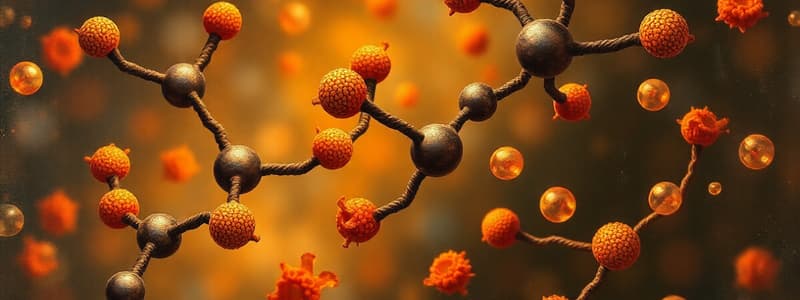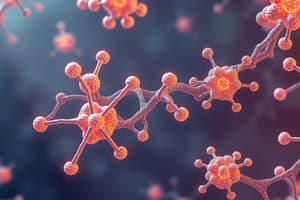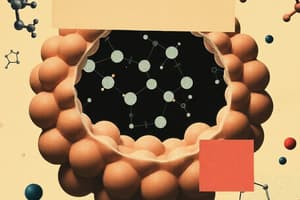Podcast
Questions and Answers
Which macromolecule is responsible for storing and transmitting genetic information?
Which macromolecule is responsible for storing and transmitting genetic information?
- Lipids
- Carbohydrates
- Nucleic acids (correct)
- Proteins
What is the monomer of proteins?
What is the monomer of proteins?
- Nucleotide
- Fatty acid
- Monosaccharide
- Amino acid (correct)
Which of the following is NOT a function of lipids?
Which of the following is NOT a function of lipids?
- Enzymatic catalysis (correct)
- Insulation
- Cell signaling
- Long-term energy storage
What is the role of an enzyme's active site?
What is the role of an enzyme's active site?
Which of these is a polysaccaride used for energy storage in animals?
Which of these is a polysaccaride used for energy storage in animals?
What is the relationship between an enzyme and its substrate?
What is the relationship between an enzyme and its substrate?
Which type of macromolecule is responsible for providing quick energy for the body?
Which type of macromolecule is responsible for providing quick energy for the body?
What is the primary structural component of cell membranes?
What is the primary structural component of cell membranes?
Flashcards
Macromolecules
Macromolecules
Large molecules essential for cell survival, including carbohydrates, lipids, proteins, and nucleic acids.
Carbohydrates
Carbohydrates
Macromolecules that provide quick energy and consist of carbon, hydrogen, and oxygen.
Monosaccharide
Monosaccharide
The simplest form of carbohydrates; single sugar units like glucose.
Lipids
Lipids
Signup and view all the flashcards
Proteins
Proteins
Signup and view all the flashcards
Nucleic Acids
Nucleic Acids
Signup and view all the flashcards
Enzymes
Enzymes
Signup and view all the flashcards
Enzyme specificity
Enzyme specificity
Signup and view all the flashcards
Study Notes
Macromolecules
- Four main macromolecules are essential for cell survival: carbohydrates, lipids, proteins, and nucleic acids.
- Each macromolecule is a large molecule composed of smaller repeating units called monomers.
Carbohydrates
- Function: Provide quick energy for the body.
- Structural components: Carbon, hydrogen, and oxygen (CH₂O ratio).
- Monomer: Monosaccharide (e.g., glucose).
- Examples: Glucose (most common monosaccharide), glycogen (animal energy storage), starch (plant energy storage), cellulose (plant structural component).
- Polysaccharides are long chains of monosaccharides.
Lipids
- Functions: Long-term energy storage, insulation, and plasma membrane formation.
- Structural components: Carbon, hydrogen, and oxygen (more carbons than oxygens).
- Monomer: Fatty acid.
- Examples: Phospholipids (plasma membrane component), cholesterol (can contribute to heart problems), steroids (sex hormones).
- Lipids are also known as fats.
- Lipids are hydrophobic (don't mix with water).
Proteins
- Functions: Act as the "workers" of the cell.
- Structural components: Carbon, hydrogen, oxygen, and nitrogen (CHON).
- Monomer: Amino acid.
- Examples: Hemoglobin (oxygen transport), insulin (blood sugar regulation), enzymes (catalyze chemical reactions).
- Many proteins end in "-ion" (e.g., insulin, collagen).
Nucleic Acids
- Functions: Store and transmit genetic information.
- Structural components: Carbon, hydrogen, oxygen, nitrogen, and phosphorus (CHONP).
- Monomer: Nucleotide.
- Examples: DNA (deoxyribonucleic acid), RNA (ribonucleic acid).
Enzymes
- Proteins that speed up chemical reactions.
- Also known as catalysts.
- Function by lowering activation energy, the amount of energy needed for a reaction to occur.
- Involved in breaking down and building molecules.
Enzyme Reactions
- Substrate: The molecule that the enzyme acts upon.
- Enzyme-substrate complex: The temporary combination of the enzyme and substrate.
- Products: The molecules resulting from the chemical reaction catalyzed by the enzyme.
5 Key Facts About Enzymes
- Shape and Function: The shape of an enzyme determines its function. The substrate fits perfectly into the enzyme's active site.
- Specificity: Enzymes are specific, meaning they only bind to one type of substrate.
- Reusability: Enzymes are not consumed during a reaction and can be used repeatedly.
- Denaturation: Enzymes can lose their shape (denature) due to high temperatures (fevers) or low pH (acidity).
- Activation Energy: Enzymes reduce the activation energy required for a reaction to occur, speeding up the process.
Enzyme Activity
- Enzymes speed up chemical reactions by lowering the activation energy needed for the reaction to occur.
- This makes the reactions happen faster.
- The graph illustrates this: the blue line represents a reaction without an enzyme (high activation energy, slow process), while the pink line depicts a reaction with an enzyme (lower activation energy, faster process).
Studying That Suits You
Use AI to generate personalized quizzes and flashcards to suit your learning preferences.



